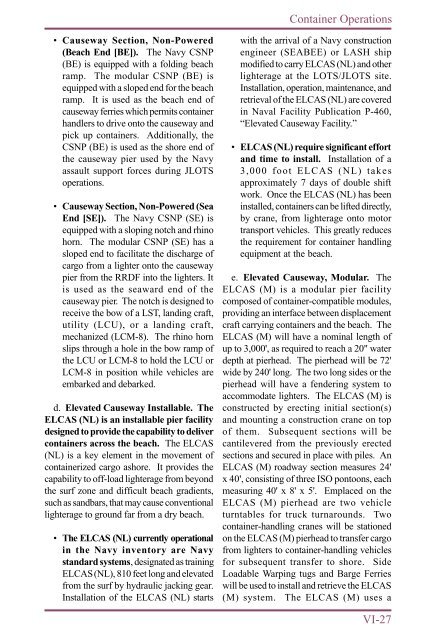JP 4-01.7 JTTP for Use of Intermodal Containers in Joint ... - BITS
JP 4-01.7 JTTP for Use of Intermodal Containers in Joint ... - BITS
JP 4-01.7 JTTP for Use of Intermodal Containers in Joint ... - BITS
Create successful ePaper yourself
Turn your PDF publications into a flip-book with our unique Google optimized e-Paper software.
• Causeway Section, Non-Powered<br />
(Beach End [BE]). The Navy CSNP<br />
(BE) is equipped with a fold<strong>in</strong>g beach<br />
ramp. The modular CSNP (BE) is<br />
equipped with a sloped end <strong>for</strong> the beach<br />
ramp. It is used as the beach end <strong>of</strong><br />
causeway ferries which permits conta<strong>in</strong>er<br />
handlers to drive onto the causeway and<br />
pick up conta<strong>in</strong>ers. Additionally, the<br />
CSNP (BE) is used as the shore end <strong>of</strong><br />
the causeway pier used by the Navy<br />
assault support <strong>for</strong>ces dur<strong>in</strong>g JLOTS<br />
operations.<br />
• Causeway Section, Non-Powered (Sea<br />
End [SE]). The Navy CSNP (SE) is<br />
equipped with a slop<strong>in</strong>g notch and rh<strong>in</strong>o<br />
horn. The modular CSNP (SE) has a<br />
sloped end to facilitate the discharge <strong>of</strong><br />
cargo from a lighter onto the causeway<br />
pier from the RRDF <strong>in</strong>to the lighters. It<br />
is used as the seaward end <strong>of</strong> the<br />
causeway pier. The notch is designed to<br />
receive the bow <strong>of</strong> a LST, land<strong>in</strong>g craft,<br />
utility (LCU), or a land<strong>in</strong>g craft,<br />
mechanized (LCM-8). The rh<strong>in</strong>o horn<br />
slips through a hole <strong>in</strong> the bow ramp <strong>of</strong><br />
the LCU or LCM-8 to hold the LCU or<br />
LCM-8 <strong>in</strong> position while vehicles are<br />
embarked and debarked.<br />
d. Elevated Causeway Installable. The<br />
ELCAS (NL) is an <strong>in</strong>stallable pier facility<br />
designed to provide the capability to deliver<br />
conta<strong>in</strong>ers across the beach. The ELCAS<br />
(NL) is a key element <strong>in</strong> the movement <strong>of</strong><br />
conta<strong>in</strong>erized cargo ashore. It provides the<br />
capability to <strong>of</strong>f-load lighterage from beyond<br />
the surf zone and difficult beach gradients,<br />
such as sandbars, that may cause conventional<br />
lighterage to ground far from a dry beach.<br />
• The ELCAS (NL) currently operational<br />
<strong>in</strong> the Navy <strong>in</strong>ventory are Navy<br />
standard systems, designated as tra<strong>in</strong><strong>in</strong>g<br />
ELCAS (NL), 810 feet long and elevated<br />
from the surf by hydraulic jack<strong>in</strong>g gear.<br />
Installation <strong>of</strong> the ELCAS (NL) starts<br />
Conta<strong>in</strong>er Operations<br />
with the arrival <strong>of</strong> a Navy construction<br />
eng<strong>in</strong>eer (SEABEE) or LASH ship<br />
modified to carry ELCAS (NL) and other<br />
lighterage at the LOTS/JLOTS site.<br />
Installation, operation, ma<strong>in</strong>tenance, and<br />
retrieval <strong>of</strong> the ELCAS (NL) are covered<br />
<strong>in</strong> Naval Facility Publication P-460,<br />
“Elevated Causeway Facility.”<br />
• ELCAS (NL) require significant ef<strong>for</strong>t<br />
and time to <strong>in</strong>stall. Installation <strong>of</strong> a<br />
3,000 foot ELCAS (NL) takes<br />
approximately 7 days <strong>of</strong> double shift<br />
work. Once the ELCAS (NL) has been<br />
<strong>in</strong>stalled, conta<strong>in</strong>ers can be lifted directly,<br />
by crane, from lighterage onto motor<br />
transport vehicles. This greatly reduces<br />
the requirement <strong>for</strong> conta<strong>in</strong>er handl<strong>in</strong>g<br />
equipment at the beach.<br />
e. Elevated Causeway, Modular. The<br />
ELCAS (M) is a modular pier facility<br />
composed <strong>of</strong> conta<strong>in</strong>er-compatible modules,<br />
provid<strong>in</strong>g an <strong>in</strong>terface between displacement<br />
craft carry<strong>in</strong>g conta<strong>in</strong>ers and the beach. The<br />
ELCAS (M) will have a nom<strong>in</strong>al length <strong>of</strong><br />
up to 3,000', as required to reach a 20" water<br />
depth at pierhead. The pierhead will be 72'<br />
wide by 240' long. The two long sides or the<br />
pierhead will have a fender<strong>in</strong>g system to<br />
accommodate lighters. The ELCAS (M) is<br />
constructed by erect<strong>in</strong>g <strong>in</strong>itial section(s)<br />
and mount<strong>in</strong>g a construction crane on top<br />
<strong>of</strong> them. Subsequent sections will be<br />
cantilevered from the previously erected<br />
sections and secured <strong>in</strong> place with piles. An<br />
ELCAS (M) roadway section measures 24'<br />
x 40', consist<strong>in</strong>g <strong>of</strong> three ISO pontoons, each<br />
measur<strong>in</strong>g 40' x 8' x 5'. Emplaced on the<br />
ELCAS (M) pierhead are two vehicle<br />
turntables <strong>for</strong> truck turnarounds. Two<br />
conta<strong>in</strong>er-handl<strong>in</strong>g cranes will be stationed<br />
on the ELCAS (M) pierhead to transfer cargo<br />
from lighters to conta<strong>in</strong>er-handl<strong>in</strong>g vehicles<br />
<strong>for</strong> subsequent transfer to shore. Side<br />
Loadable Warp<strong>in</strong>g tugs and Barge Ferries<br />
will be used to <strong>in</strong>stall and retrieve the ELCAS<br />
(M) system. The ELCAS (M) uses a<br />
VI-27
















